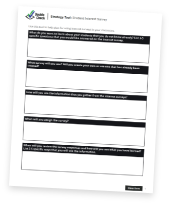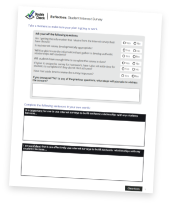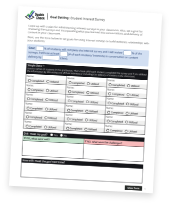Strategy: Student Interest Survey
Check-Up Menu > Student Interest Survey
What if a student needs a topic for a project but can’t think of one or the teacher wants to develop authentic relationships by learning more about their students? An interest survey can be very helpful!
Interest surveys allow teachers to learn things about students that may not typically come to their attention. Besides providing insights into the kinds of things students may want to study in depth, the survey can help motivate reluctant learners. Raymond Wlodkowski, an educational psychologist and expert on motivation, has found that one of the quickest ways to motivate students is to discover what they are interested in outside of school, then spend a short time each day talking with them about their interests. You may wish to survey all of your students at the beginning of the school year, but interest surveys can be used at any time as a way to engage your students.
How To
There are many different ways interest surveys can be used.
1) Pick or create an interest survey based on your desired outcomes and students’ developmental level (see example below). You may want to know about students’ favorite foods and games if you want to make celebrations and flexible time in the classroom more fun. If you want to make classroom content more engaging, you might ask about students’ favorite books, subjects, etc. Younger students may need to draw their responses or circle yes/no or smiley face/sad face response options. Older students can write out their responses.
2) Administer the survey in class or assign it as homework.
3) Review the responses and use the information in conversations with students and while delivering instruction.
Example Interest Survey:
Note: This sample interest survey is aimed at collecting a lot of information from each student. You may want to just choose a portion of the questions to first provide to your students. You can always edit and modify interest surveys so that they make sense to you, and you can always provide them to students more than just one time during the year.
- What kind of books to you like to read?
- How do you get the news? What parts of the newspaper do you look at regularly?
- What are your favorite magazines or Web sites?
- What types of TV programs do you prefer? Why?
- What is your favorite activity or subject at school? Your least favorite? Why?
- What is your first choice about what to do when you have free time at home?
- What kinds of things have you collected? What do you do with things you collect?
- If you could talk to any person currently living, who would it be? Why? Think of 3 questions you would ask the person.
- If you could talk to any person from history, who would it be? Why? Think of 3 questions you would ask the person.
- What are your hobbies? How much time do you spend on your hobbies?
- If you could have anything you want, regardless of money or natural ability, what would you choose? Why?
- What careers(s) do you think might be suitable for you when you are an adult?
- If you could spend a week job-shadowing any adult in any career, which would you choose and why?
- Tell about your favorite games.
- What kind of movies do you prefer? Why?
- Imagine that someday you will write a book. What do you think it will be about?
- Describe 10 things that would be present in a perfect world. Describe an invention you would create to make the world a better place.
- What places in the world would you most like to visit? Why? Tell about your favorite vacation—one you’ve taken or wish you could take.
- Imagine that you’re going to take a trip to another planet or solar system. You’ll be gone for 15 years. List 10 things you will take with you to do in your spare time.
- What questions do you think should be on this survey that are not already on it?
Strategy Tool

Reflection

Goal Setting
